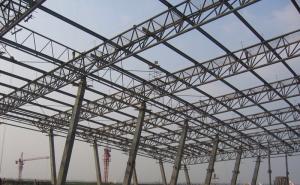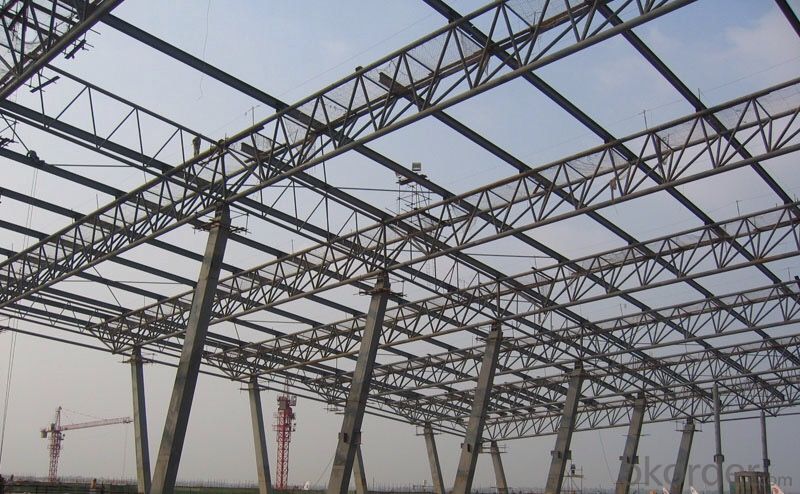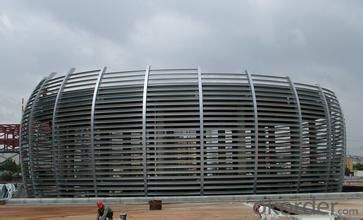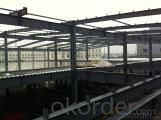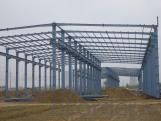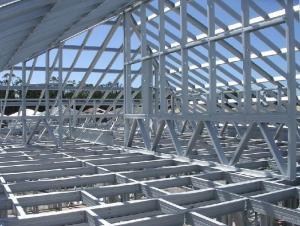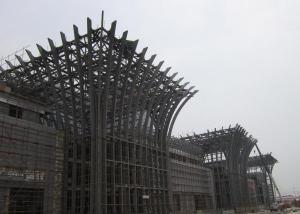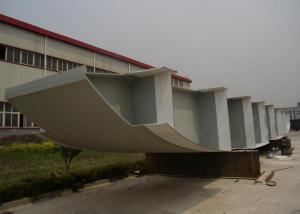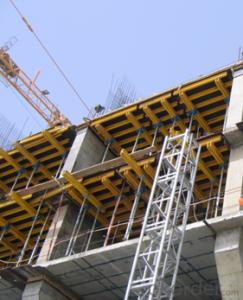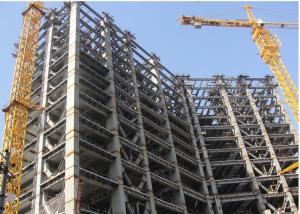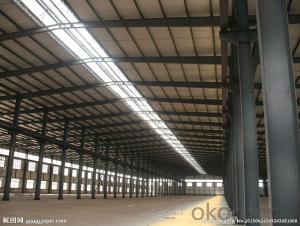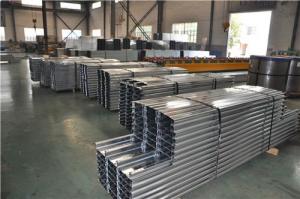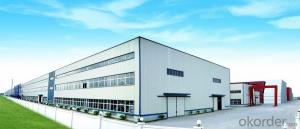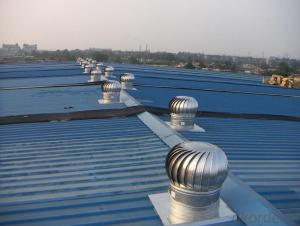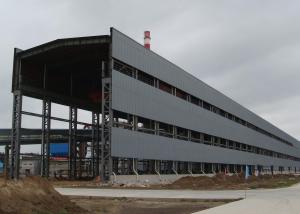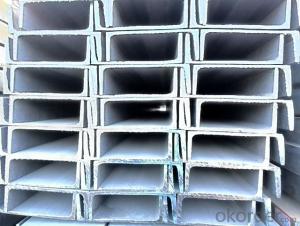Grid Frame Structure Steel Structure
- Loading Port:
- China Main Port
- Payment Terms:
- TT or LC
- Min Order Qty:
- -
- Supply Capability:
- -
OKorder Service Pledge
OKorder Financial Service
You Might Also Like
OKorder is offering Grid frame structure steel structure at great prices with worldwide shipping. Our supplier is a world-class manufacturer of steel, with our products utilized the world over. OKorder annually supplies products to European, North American and Asian markets. We provide quotations within 24 hours of receiving an inquiry and guarantee competitive prices.
Product Applications:
Grid frame structure steel structure are ideal for structural applications and are widely used in the construction of buildings and bridges, and the manufacturing, petrochemical, and transportation industries.
Product Advantages:
Grid frame structure steel structure are durable, strong, and resist corrosion.
Main Product Features:
· Premium quality
· Prompt delivery & seaworthy packing (30 days after receiving deposit)
· Corrosion resistance
· Professional Service
· Competitive pricing
Product Specifications:
Specifications
1) . Easy to install, fire proof, good insulation
2). Certification: ISO9001:2000, SGS Standard.
Steel Structure Warehouse:
1.The steel structure of the connection method: welding connection
2.Steel structure design common norms are as follows: "Steel Design Code" (GB50017-2003) Cold-formed steel structure technical specifications" (GB50018-2002) "Construction Quality Acceptance of Steel" (GB50205-2001) "Technical Specification for welded steel structure" (JGJ81-2002, J218-2002) "Technical Specification for Steel Structures of Tall Buildings" (JGJ99-98)
3.The characteristics of steel Light weight steel structure Higher reliability of steel work Steel anti-vibration (earthquake), impact and good Steel structure for a higher degree of industrialization Steel can be assembled quickly and accurately Large steel interior space Likely to cause sealing structure Steel corrosive Poor fire-resistant steel Recyclable steel shorter duration
4.Commonly used steel grades and performance of steel Carbon
structural steel: Q195, Q215, Q235, Q255, Q275, etc.
High-strength low-alloy structural steel Quality carbon structural steel and alloy structural steel Special purpose steel Product Feature Carport, House, Office, Shop, Toilet, Villa, Warehouse, Workshop, Plant Other Information
Products have been all over the country more than 20 provinces, municipalities and autonomous regions, and have been exported to Europe, North America, the Middle East, Africa, Asia and other countries and regions, the widespread use
FAQ:
Q1: Why buy Materials & Equipment from OKorder.com?
A1: All products offered byOKorder.com are carefully selected from China's most reliable manufacturing enterprises. Through its ISO certifications, OKorder.com adheres to the highest standards and a commitment to supply chain safety and customer satisfaction.
Q2: How do we guarantee the quality of our products?
A2: We have established an advanced quality management system which conducts strict quality tests at every step, from raw materials to the final product. At the same time, we provide extensive follow-up service assurances as required.
Q3: How soon can we receive the product after purchase?
A3: Within three days of placing an order, we will begin production. The specific shipping date is dependent upon international and government factors, but is typically 7 to 10 workdays.
Images:

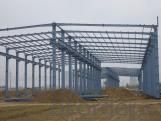
- Q: How are steel structures designed for thermal comfort?
- Various strategies can be employed to achieve thermal comfort in steel structures, aiming to regulate internal temperature and enhance occupants' comfort. Insulation is a key consideration, as effective insulation materials incorporated into the walls, roofs, and floors of steel structures can minimize heat transfer, reducing heat gain or loss from the external environment. This insulation helps maintain a stable internal temperature, minimizing the need for excessive heating or cooling. Efficient HVAC systems are another aspect of thermal comfort design for steel structures. These systems can be tailored to provide adequate heating or cooling based on the specific requirements of the building and its occupants. By ensuring proper airflow and temperature control, occupants can enjoy a comfortable indoor environment throughout the year. The orientation and placement of windows and shading devices are also important design considerations. By strategically positioning windows to maximize natural light while minimizing direct sunlight exposure, passive solar heating can be utilized to provide additional warmth during colder months. Shading devices like blinds or overhangs can also help prevent solar heat gain during warmer months, preventing overheating. The selection of appropriate building materials plays a crucial role in steel structure design for thermal comfort. For example, using high-performance glazing with low solar heat gain coefficients can help reduce unwanted heat transfer. Additionally, incorporating thermal mass materials like concrete or stone in the building envelope can regulate temperature fluctuations by absorbing and releasing heat gradually. Lastly, advanced technologies such as smart controls and energy management systems can optimize energy consumption and enhance thermal comfort. These systems can monitor and adjust temperature, humidity, and ventilation levels based on occupancy patterns and weather conditions, ensuring a comfortable and energy-efficient indoor environment. In conclusion, achieving thermal comfort in steel structures involves implementing insulation, efficient HVAC systems, strategic window placement, shading devices, appropriate building materials, and advanced technologies. Architects and engineers can create steel structures that promote a comfortable and sustainable living or working environment by considering these factors.
- Q: How is steel used in bridges?
- Due to its exceptional strength and durability, steel is widely employed in the construction of bridges. It is a versatile material that can be shaped and welded into different structural components, making it ideal for supporting heavy loads. Bridges utilize steel in several ways: 1. Structural Frames: Steel is commonly used to form the main framework of a bridge, including the support beams, columns, and trusses. These components provide the necessary strength and stability to withstand the weight of vehicles, pedestrians, and other loads. 2. Bridge Deck: Steel is also employed in constructing bridge decks, which serve as the surfaces for vehicles and pedestrians. Steel plates or grating are often placed on top of the structural framework to create a stable and durable surface. These decks can be designed with various protective coatings to prevent corrosion and enhance longevity. 3. Suspension and Cable-Stayed Bridges: Steel plays a crucial role in the construction of suspension and cable-stayed bridges. These types of bridges utilize steel cables and suspenders to support the deck, enabling longer spans and more design flexibility. The strength and flexibility of steel make it an ideal material for these bridge structures. 4. Expansion Joints: Steel expansion joints are used to accommodate the thermal expansion and contraction of bridges caused by temperature fluctuations. These joints allow the bridge to expand and contract without causing damage or structural failure. 5. Reinforcement: Concrete components of bridges often incorporate steel reinforcement bars, also known as rebar, to enhance their strength and prevent cracking or crumbling. The steel reinforcement helps distribute loads evenly and increase the overall resilience of the bridge. In conclusion, steel's high strength-to-weight ratio, durability, and versatility make it an essential material in bridge construction. Its use in various bridge components ensures the structural integrity and longevity of bridges, enabling them to safely support heavy loads and withstand the test of time.
- Q: How are steel structures repaired in case of damage?
- Steel structures are repaired in case of damage through various methods. First, the damaged area is assessed to determine the extent and nature of the damage. Once identified, the damaged section is typically cut out and replaced with a new steel component. Welding is commonly used to join the new piece with the existing structure. In some cases, strengthening techniques like adding additional steel plates or braces are employed to reinforce the repaired area. Regular inspections and maintenance are crucial to identify and address any potential damage early on, ensuring the longevity and safety of the steel structure.
- Q: How are steel structures used in the construction of stadiums and sports complexes?
- Steel structures are commonly used in the construction of stadiums and sports complexes due to their strength, durability, and versatility. They provide the necessary support for large spans and can withstand heavy loads, allowing for the creation of vast open spaces and grandstands. Steel beams and columns are used to create the framework of the structure, while steel trusses are employed to support the roof and provide an unobstructed view for spectators. Additionally, steel's flexibility allows for the creation of unique architectural designs, making it an ideal material for constructing modern and iconic sports facilities.
- Q: What is the difference between hot-rolled and cold-formed steel structures?
- Hot-rolled steel structures are produced by heating the steel to a high temperature and then rolling it into shape, resulting in a stronger and more flexible material. Cold-formed steel structures, on the other hand, are formed at room temperature through a process of bending or pressing, which produces a more precise and uniform product. The main difference lies in their manufacturing methods, with hot-rolled steel structures being suitable for larger and heavier applications, while cold-formed steel structures are commonly used for lighter and more intricate designs.
- Q: What are the design considerations for steel structures in high-rise buildings?
- Some of the key design considerations for steel structures in high-rise buildings include the strength and stability of the steel framework, the ability to resist lateral loads such as wind and earthquakes, fire protection measures, and the integration of various building systems such as mechanical, electrical, and plumbing. Additionally, factors like the weight of the steel members, constructability, and cost-effectiveness are also important considerations in the design process.
- Q: What are the considerations for steel structures in areas with high wind speeds?
- When designing steel structures in areas with high wind speeds, several considerations need to be taken into account. First and foremost, the structural design should be able to withstand the increased wind loads. This involves assessing the wind speed and direction, considering the local topography, and implementing appropriate design codes and standards. Additionally, the selection of materials and construction techniques should prioritize durability and resistance to wind-induced forces. High-quality steel with proper corrosion protection should be used, and connections between structural members should be robust and capable of withstanding the wind loads. Another important consideration is the aerodynamics of the structure. The shape and orientation of the building should be carefully designed to minimize wind resistance and reduce the effects of turbulence. This can be achieved by incorporating streamlined features, tapering the structure, or using wind deflectors. Furthermore, the foundation system must be designed to resist the uplift forces generated by high winds. Deep and well-designed footings or pile foundations are often necessary to ensure stability and prevent structural failure. Regular inspection, maintenance, and repairs are also crucial in areas with high wind speeds. Special attention should be given to the connection points, joints, and any potential weak spots to ensure the ongoing integrity of the structure. Overall, the considerations for steel structures in areas with high wind speeds involve a comprehensive analysis of wind loads, appropriate material selection, aerodynamic design, robust connections, proper foundation systems, and regular maintenance. These measures aim to ensure the safety, stability, and durability of the structure under extreme wind conditions.
- Q: How do steel structures perform in terms of natural ventilation and air quality?
- Steel structures can provide good natural ventilation due to their ability to incorporate large openings for windows and doors. This allows for effective airflow and circulation of fresh air, which can enhance air quality within the building. Additionally, steel structures can be designed with features such as louvers and vents to further improve natural ventilation and promote better indoor air quality.
- Q: What are the challenges associated with erecting steel structures?
- Erecting steel structures presents a number of challenges. The complexity of the construction process stands as one main obstacle. Meticulous planning and coordination are necessary to align and connect all components properly. This involves careful consideration of the structural design, fabrication, transportation, and installation. Additionally, the weight and size of steel components pose another challenge. Transporting and lifting these heavy parts can be difficult and demand specialized equipment. The size of the components can also create logistical difficulties, particularly in confined spaces or urban environments. Safety is a paramount concern when erecting steel structures. Workers must adhere to strict safety protocols to prevent accidents and injuries. This includes receiving proper training in the use of heavy machinery, ensuring fall protection, and following safety guidelines during installation. Weather conditions can also complicate the erection process. Wind, rain, and extreme temperatures can jeopardize the stability of the structure and put workers at risk. Consequently, construction schedules must be carefully planned to minimize exposure to adverse weather conditions. Moreover, the cost associated with erecting steel structures can be challenging. The materials and equipment required for steel construction are expensive, and labor costs for skilled workers can also be high. Thus, careful budgeting and cost management are necessary to ensure the project stays within the allocated financial resources. In conclusion, erecting steel structures demands careful planning, coordination, and consideration of various challenges. Nonetheless, with proper preparation and experienced professionals, these hurdles can be overcome to successfully complete construction projects.
- Q: What are the guidelines for the construction and erection of steel structures?
- The guidelines for the construction and erection of steel structures typically include factors such as design considerations, material selection, fabrication and welding techniques, quality control measures, safety protocols, and compliance with building codes and regulations. These guidelines ensure that steel structures are built and erected efficiently, safely, and in accordance with industry standards for structural integrity and performance.
Send your message to us
Grid Frame Structure Steel Structure
- Loading Port:
- China Main Port
- Payment Terms:
- TT or LC
- Min Order Qty:
- -
- Supply Capability:
- -
OKorder Service Pledge
OKorder Financial Service
Similar products
Hot products
Hot Searches
Related keywords
